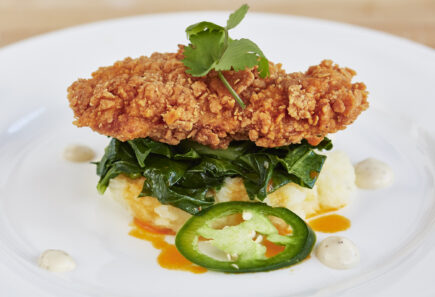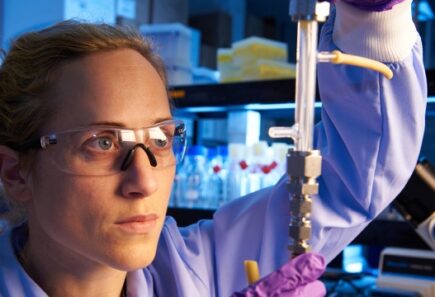BOB体育投注网址
Your guide to the science, business and policy of cultivated meat in Europe.

What is cultivated meat?
BOB体育投注网址培养肉是一模一样的牛肉,pork, chicken and seafood people enjoy eating today – but grown directly from animal cells, instead of farming animals.
Why do we need cultivated meat?
Compared with conventional meat production, cultivated meat has the potential to be far less resource-intensive, decreasing methane emissions, deforestation, biodiversity loss, water use, water pollution, antibiotic resistance, and foodborne illnesses.
Arecent study by CE Delft– the first ever to be based on data from cultivated meat companies – found that, compared with farming animals, cultivating meat from cells could:
- Cut the climate impact of meat by up to 92%.
- Reduce air pollution by up to 94%.
- Use up to 90% less land.
This is compared to an ambitious scenario for conventional animal agriculture in 2030 – where farmers manage to cut the carbon footprint of meat by 15% (for beef), 26% (for pork) and 53% (for chicken). Compared with current average environmental impacts, the benefits of cultivated meat are even greater. And if we use the freed-up land for rewilding or carbon sequestration, the positive climate impacts could be greater still.
Cultivated meat is also made in clean environments without animals or exposure to faecal pathogens, and no antibiotics are needed – so these foods help toreduce the risk of zoonotic diseases, prevent foodborne illnesses, and preserve life-saving antibiotics for human medicine.
Cultivated meat will expand the options available to consumers, providing the meat so many people desire, just produced in a more sustainable, secure and just way.
How is cultivated meat made?
Cultivating meat is similar to growing plants from cuttings in a greenhouse, which provides warmth, fertile soil, water and nutrients. This new method of meat production enables the natural process of cell growth, but in a more efficient environment.
Cellular agriculture involves taking a small, harmless sample of cells from an animal and growing them in what is known as a cultivator. The cultivator facilitates the same biological process that happens inside an animal by providing the cells the warmth and the basic nutrients needed to transform into meat: water, proteins, carbohydrates, fats, vitamins and minerals. The result is an abundance of cultivated meat, identical to conventionally produced meat at the cellular level, but made in a more sustainable way.
When will cultivated meat be available in Europe?
On 2 December 2020, Singapore became the first country in the world toapprove cultivated meat for sale– and people can now order cultivated chicken via a food delivery app. The fact that cultivated meat has passed this rigorous approval process shows that it will be part of a safe and sustainable food future. But it is likely to be some years before people in Europe are able to buy cultivated meat from the supermarket – and how soon that happens will depend on how much governments invest in open-access research.
Before a cultivated meat product can be sold in Europe, it needs to be approved by regulators. In the EU, once regulators approve a cultivated meat product, it can be sold across all 27 EU countries. The approval process will include a thorough and evidence-based assessment of the safety and nutritional value of cultivated meat, and is estimated to take at least 18 months.
Many other European governments have similar regulatory frameworks in place for the assessment and authorisation of cultivated meat.
GFI Europe isworking with the EU and national governmentsto ensure that the regulatory approval process for cultivated meat is robust, clear, and evidence-based.
How can we advance cultivated meat in Europe?
The world’s first cultivated beef burger was unveiled in London in 2013. Since then, startups across Europe have made incredible progress in developing cultivated meat – but it will take government investment to truly transform meat production and maximise the societal benefits of cultivated meat.
Public sector investment in open-access research can address foundational issues and support the growth of a whole sector, rather than just one company. Just like they fund research and development into green energy, governments interested in building a sustainable food system should fund open-access research into plant-based and cultivated meat, and other sustainable proteins.
Research by CE Delftshows that by 2030, cultivated meat’s production costs could fall to just €5.73/£4.80 per kg. To achieve this, both the public and private sectors will need to invest significant sums into research and development to overcome existing challenges – and CE Delft’s research shows that enhancing taste, reducing prices, and delivering key infrastructure will be crucial.
GFI Europe’s own market research suggests developing species-specific research toolkits, scaling and optimising cultivated meat inputs, and educating consumers will also be crucial.
Why is it called cultivated meat?
Many terms have been used to describe meat grown from cells – from “slaughter-free meat” to “cultured meat” and “lab-grown meat”. “Lab-grown meat” is an especially misleading term. At scale, cultivated meat is produced in cultivators, in a facility similar to a brewery. All sorts of food, from beer to bread, begins in a food lab – but we don’t call cornflakes “lab-created cornflakes”.
Cultivating meat can be thought of in the same way as cultivating plants in a greenhouse, where plant cuttings are given warmth, fertile soil, water and nutrients to help them to grow. A cultivator is what cultivated meat grows in. This is a reactor which facilitates the same biological process that happens inside an animal by providing warmth and the basic elements needed to build muscle: water, proteins, carbohydrates, fats, vitamins and minerals.
To achieve the incredible potential of cultivated meat to help tackle the climate crisis, restore nature, protect public health and improve food security, consumers must understand and embrace it. In 2019, GFI began using the term “cultivated” following anextensive research projectto develop anarrativeand decide on a term that was neutral, understandable and appealing to consumers.

The science of cultivated meat
Learn more about the science and technology behind cultivated meat – and the white spaces where more research is needed to accelerate the transition to a sustainable, secure and just food system.
The business of cultivated meat
Europe’s cultivated meat sector is developing rapidly, with companies producing everything from beef burgers to foie gras.
In 2022, European cultivated meat companies raised atleast €120 million. This amounts to more than half of the total raised by European cultivated meat companies between 2016 and 2021.


The policy of cultivated meat
Cultivated meat needs government support and approval before it can deliver on its potential to help tackle the climate and ecological emergency, protect public health and enhance food security.
GFI Europe advocatespublic investmentin cultivated meat R&D,evidence-based regulation, andtransparent labelling rulesto help consumers make more sustainable choices.








